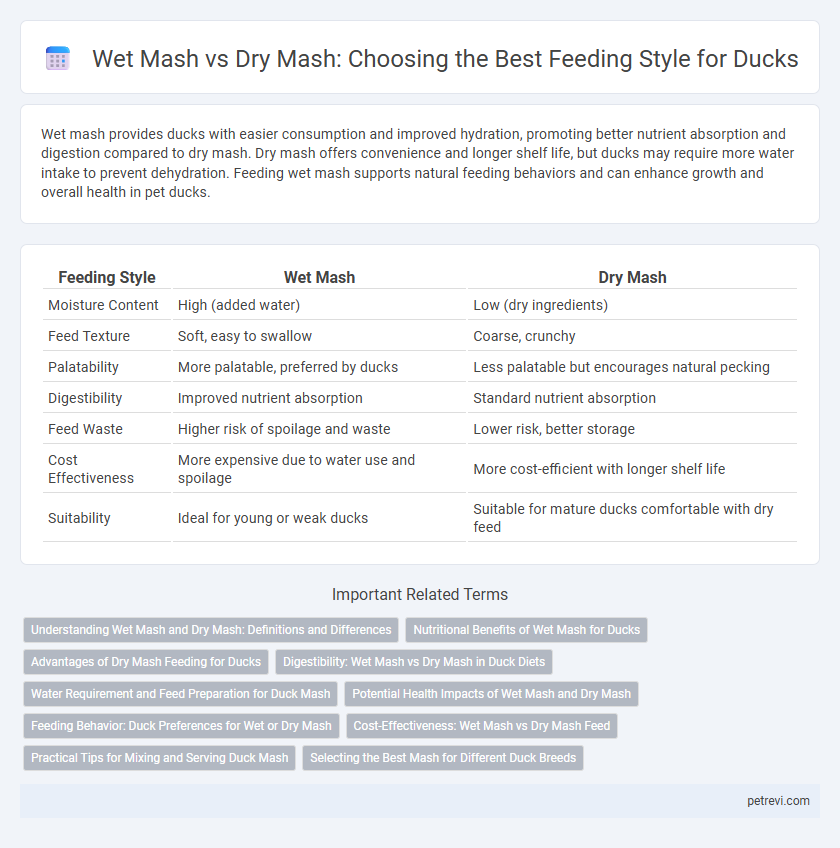Wet mash provides ducks with easier consumption and improved hydration, promoting better nutrient absorption and digestion compared to dry mash. Dry mash offers convenience and longer shelf life, but ducks may require more water intake to prevent dehydration. Feeding wet mash supports natural feeding behaviors and can enhance growth and overall health in pet ducks.
Table of Comparison
| Feeding Style | Wet Mash | Dry Mash |
|---|---|---|
| Moisture Content | High (added water) | Low (dry ingredients) |
| Feed Texture | Soft, easy to swallow | Coarse, crunchy |
| Palatability | More palatable, preferred by ducks | Less palatable but encourages natural pecking |
| Digestibility | Improved nutrient absorption | Standard nutrient absorption |
| Feed Waste | Higher risk of spoilage and waste | Lower risk, better storage |
| Cost Effectiveness | More expensive due to water use and spoilage | More cost-efficient with longer shelf life |
| Suitability | Ideal for young or weak ducks | Suitable for mature ducks comfortable with dry feed |
Understanding Wet Mash and Dry Mash: Definitions and Differences
Wet mash for duck feeding involves mixing grains with water to create a moist, easily digestible feed that supports hydration and nutrient absorption. Dry mash consists of finely ground grains without added moisture, offering convenience and reduced spoilage risk but may require ducks to drink more water. Understanding these differences helps optimize duck nutrition and overall health by balancing moisture content and feed management.
Nutritional Benefits of Wet Mash for Ducks
Wet mash feeding for ducks offers enhanced digestibility and moisture content, supporting hydration and nutrient absorption crucial for growth and health. The high water content in wet mash promotes better intake of essential vitamins, minerals, and proteins, leading to improved feed conversion efficiency. Ducks fed with wet mash typically exhibit stronger immune responses and better weight gain compared to those given dry mash.
Advantages of Dry Mash Feeding for Ducks
Dry mash feeding for ducks offers precise nutrient control, promoting consistent growth and improved feed efficiency. This method reduces the risk of feed spoilage and contamination, enhancing overall flock health. Additionally, dry mash minimizes waterborne pathogens compared to wet mash, supporting better digestive health in ducks.
Digestibility: Wet Mash vs Dry Mash in Duck Diets
Wet mash diets for ducks generally offer higher digestibility due to increased moisture content, which aids enzymatic activity and nutrient absorption in the gastrointestinal tract. Dry mash, while more convenient for storage, can reduce feed intake efficiency as ducks expend more energy to hydrate and process the feed, potentially limiting nutrient availability. Research indicates that ducks fed wet mash show improved growth performance and feed conversion ratios compared to those on dry mash diets.
Water Requirement and Feed Preparation for Duck Mash
Wet mash for duck feeding involves mixing feed with water, increasing water intake and improving digestibility, crucial for optimal growth and hydration. Dry mash requires less preparation but demands more free water availability to meet the duck's hydration needs, impacting overall water consumption. Proper feed preparation with wet mash enhances nutrient absorption and reduces feed wastage, supporting efficient duck nutrition management.
Potential Health Impacts of Wet Mash and Dry Mash
Wet mash feeding for ducks can increase the risk of bacterial and fungal growth due to higher moisture content, potentially leading to digestive issues and infections. Dry mash reduces moisture, lowering the chance of pathogen proliferation but may cause dehydration if ducks are not provided with adequate water. Monitoring feed moisture and duck hydration is essential to minimize health risks and ensure optimal digestive function.
Feeding Behavior: Duck Preferences for Wet or Dry Mash
Ducks exhibit a natural preference for wet mash due to its softer texture and easier digestibility, which closely resembles their natural feeding habits of dabbling in water. Wet mash promotes better nutrient absorption and hydration, enhancing overall feed intake and growth rates compared to dry mash. Conversely, dry mash may encourage pecking behavior and can lead to lower feed efficiency due to its harder consistency and reduced palatability.
Cost-Effectiveness: Wet Mash vs Dry Mash Feed
Wet mash feed for ducks often reduces feed wastage and improves nutrient absorption, leading to better growth rates and cost savings over time. Dry mash is easier to store and handle but can result in lower feed intake and increased feed spillage, potentially raising overall feeding costs. Analyzing specific farm conditions and duck behavior can help determine the more cost-effective option between wet and dry mash feeding methods.
Practical Tips for Mixing and Serving Duck Mash
Wet mash for ducks enhances palatability and digestion by combining dry feed with water at a 1:1 or 2:1 ratio, promoting higher intake and nutrient absorption. Use clean, lukewarm water to mix the mash, ensuring it remains moist but not soupy to prevent spoilage and wastage. Serve fresh wet mash twice daily, cleaning feeding troughs regularly to maintain hygiene and avoid mold or bacterial growth.
Selecting the Best Mash for Different Duck Breeds
Wet mash offers higher moisture content that aids digestion and is preferable for young ducklings, especially Pekin and Rouen breeds which benefit from the easy-to-consume texture. Dry mash provides concentrated nutrients and is ideal for heavier breeds like Muscovy ducks, supporting their slower growth rate and reducing the risk of overhydration. Selecting the best mash depends on the breed's age, weight, and digestive needs to optimize health and growth performance.
Wet mash vs Dry mash for Duck feeding style Infographic

 petrevi.com
petrevi.com